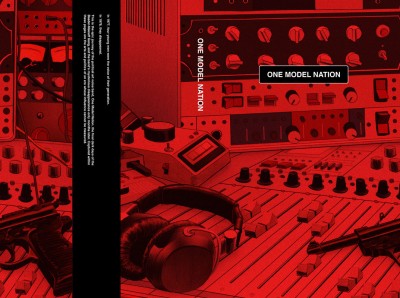An Interview with Donovan Leitch: The Historian of One Model Nation
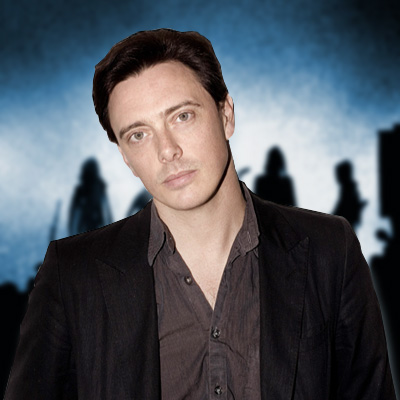
Introduction: The graphic novel One Model Nation will come out at the end of November and as fans of both comic books and music we throughly enjoyed this book which takes place in an alternate universe version of Berlin in 1977. We were lucky to get an interview with Donovan Leitch, the official historian of this tale who collaborated with writer Courtney Allbritton Taylor and artist Jim Rugg to bring this illustrated rock epic to life.
How did you come to hook up with Courtney Allbritton Taylor to conceive of this graphic novel; And coming from a musical lineage why did you pick the medium of a graphic novel to express firstly your concept? And were there any previous attempts by musicians collaborating with comic book artists that inspired you to take the plunge?
Courtney and I have been friends for a very long time and the idea for One Model Nation came out of many late night alcohol fueled discussions about music in general. We both have a strong affinity for the music that was coming out of Germany in the mid-70’s and I began to research what would become One Model Nation. This was an eight year process that started as a screenplay and ended up a graphic novel. Actually, it was never our intention to write a graphic novel. It wasn’t until Courtney gave the script to mike allred that the idea came to shape. As far as previous musicians, we knew of none. Although we went to Comic Con this year and hung out with Gerard Way of My Chemical Romance who has the very successful and cool Umbrella Academy series.
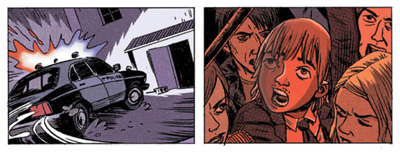
As a theme there’s something very rich and almost magical about the idea of the trine of music, youth and rebellion: What attracted you to the subject matter as a story?
Music, youth, and rebellion is like bagels, cream cheese, and lox to me. I was always fascinated by those intersecting factions. Quadrophenia still stands as one of my all time faves. Along with The Clash’ Rude Boy, A Clockwork Orange, the punk scene, you name it. I think it starts with the youth listening to the music which leads to rebellion. It is pure passion.
Coming from the perspective of a rock historian, why did you go with an alternative history approach as opposed to a more literal one? And were there any previous alterative history graphic novels (or novels/films) that inspired you?
This was an interesting process from a historical perspective. I got pretty deep into the research on the Baader-Meinhof Gang. There were loads of German films made about the terrorist group, books of course, the art of Gerhard Richter, Fassbinder, even a film this year called The Baader-Meinhof Complex. And I found a great website for reference called This is Baadermeinhof. Then I went pretty deep into the history of Kraftwerk because they were the template for One Model Nation. And of course there were some amazing finds on YouTube. Even now I am still uncovering information. And the most amazing thing is that all this info is mostly unknown in america. Some crazy shot went down in Germany during the mid to late 70’s. But we wanted to make our own version, thus we decided to go with the historical fiction route. So there are lots of scenes in the novel that actually happened. We just reimagined it. Watching Inglourious Basterds, I was happy we went that way because Tarantino did the same thing. He took historical figures and settings and reinvented them. And that movie is a graphic novel come to life if you ask me.
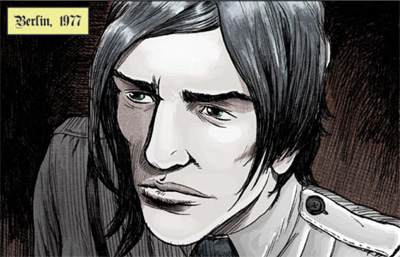
Why Berlin, and why 1977? Was there something in the actual history ad place that drew you to this time?
I think I alluded to this in the last question. Berlin has always held a dark and mysterious vibe. And in 1977 you has an entire generation that was referred to as Hitler’s children. They were the offspring of a generation that committed the most heinous crimes against humanity since the inquisition. Yet these kids yearned for their own identity. Then you had the country split into 14 provinces. After the war Germany was prevented from being a super power, so it was very easy to commit a crime, move to a different city and change your identity, and there was no record. And there was Communism vs. Capitalism. That whipped up some discontent. And you had some amazing bands making music at the time. And artists like David Bowie and Lou Reed going to Berlin to record. All of this made for a very tumultuous era.
Your novel depicts characters who are being confronted by violence on both sides (the police as the establishment and the Red Army Faction as a hoodlums), as Gen Xer who came of age with gangsta rap in the late 80s what are your thoughts on this?
That is the heart of our story. One Model Nation is a band that just wants to create music. But they have fans on one side who want to use their music and influence to create a revolution. And then there are the secret police and shady government types who want to use the band as a propaganda tool. And the band just want to be left alone to make music. I think this is a situation that many artists find themselves in. Whether it be gangsta rap, Marilyn Manson, or Randy Newman singing about short people. An artist should be free to express themselves in any manner they seem necessary. So I guess this is also a story about the dangers of censorship.
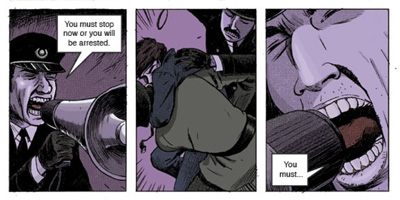
The illustrational style and the color palette of the graphic novel are evocative of German Impressionism; where there specific visual artists that you were thinking of when you conceived and researched your writing for the novel?
I think this is really more of a Jim Rugg question. The graphic novel was the last stage of the long odyssey of One Model Nation. Jim was totally inspired and Jon Fell, Courtney’s old friend and the colorist, was in the zone. We did send Jim lots of photos of the era for inspiration and I think that kick started the look. But again, I’d just be speculating.
On the website you have some original music to accompany the graphic novel – is there more to come? And of course reading comics and listening to music go together – are there specific songs that you’d recommend to your readers?
We have complied 11 One Model Nation tracks that will eventually all be heard. And I wouldn’t be surprised if the band reunited at next years Comic Con. The music is really great. I’m excited for everyone to hear it.
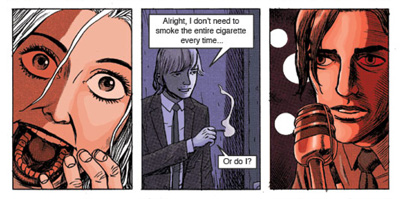
Are there plans for any follow up books? Or even follow up projects in other mediums? Your graphic novel is crying to be animated, are you working to make this happen?
Since this started as a film idea, I think the graphic novel is going to be a great sales tool to get an animated show up and running. My friend FJ Desanto who produced The Spirit is way into the book and hopefully he or someone like him will champion the next stage. We do have a sequal in mind and we have already started mapping it out. It will take place in South America.
The music business in the non-fictional world seems to be going through some hard times and ready for a shake up. Having seen so much of that world first hand and being a historian of it, where should we be looking for the next big thing? And also what current music inspires you?
The next big thing is going to come out of the bedroom of some kid who has created his own Twitter/MySpace/Facebook identity, recorded his music on ProTools, and found a following outside the system. Actually it is happening everyday. The industry is grasping at the control but they don’t know what to do. My inspirations come from so many different sources. I try to not get locked into the past. I love looking for the next sound.
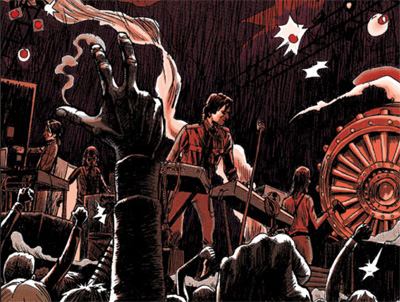
The Bonus Round! Mr. Leitch was quite kind and induldged us with two questions that only a cinema fanboy could ask…
You had the role of a dancer in the cult classic 80s film Breakin’ 2: Electric Boogaloo, do you have any special memories of what it was like to be on the set of the film when a new genre of music was breaking out and what did you think about it at the time?
I was so young when I made that film and went through my breaking stage. But I absolutely loved it. I had a breakin’ name – Dono-Dee, and I was the coolest white kid in town!
You also had the role of filmmaker Gerard Malanga in the beloved art house film I Shot Andy Warhol: What were your thoughts on that role? And did you ever get a chance to speak with Malanga before or after the film?
I spoke to gerard a few times on the phone and that film was such a blast to make. I was just hanging out with Jared Harris the other night reminiscing about the film.
Thank you — in my book Donovan Leitch is hereby fanboy approved!















